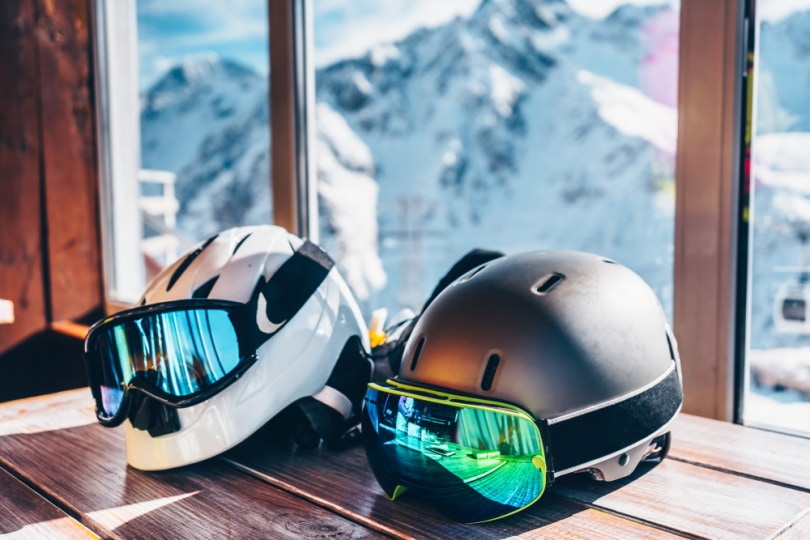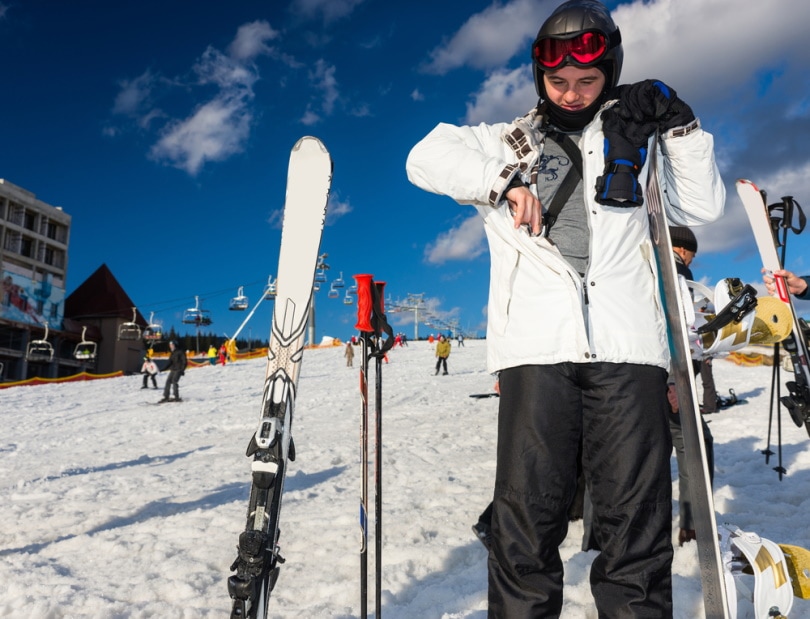How to Keep Ski Goggles From Fogging: 13 Tips & Tricks
Last Updated on

Have you ever gone down a fresh coat of powder only to be held back by that infuriating fog buildup inside your goggles? You probably ask yourself, “What can I do to keep my ski goggles from fogging?”
If you have this question in mind, then this is a great place to learn what you can do to prevent it and what causes it to happen. Our top 13 tips and tricks are proven to help reduce condensation, with several different techniques that will get you back to having fun with your friends and family on the slopes. Keep in mind that these are in no particular order because the best solution depends on your scenario.

Before You Begin
The cause of foggy lenses is condensation that is trapped inside and can’t be aired out without certain tools or techniques. As a preface, some things on this list are products that may require you to budget money. However, there are several affordable options and plenty that don’t force you to purchase anything at all. Just keep in mind the limitations you may have without premium gear.
The 13 Tips to Keep Ski Goggles From Fogging
1. Get a Dedicated Ski Mask or Baklava

Facial covers can be a great way to make air travel away from you if you use the right kind. Ones that have a nose ventilation area will increase breathability and force the air outside the mask. You’ll want to look for ski masks that are specifically made for skiing or snowboarding, as they are likely to have the best airflow. They’re also inexpensive, so there’s no need to worry about breaking the bank.
2. Try Anti-Fog Spray

The cheap solution for this problem is to find a bottle of anti-mist spray. This can fit right in the pocket of your jacket and acts as a thin layer of liquid that absorbs perspiration. It shouldn’t be too hard to find because most outdoor retailers will have them in stock during winter.
To use them, just drizzle a small amount inside the lens and use a non-abrasive microfiber cloth to wipe it throughout. Be careful, though. Using this too often can damage any coatings that are applied to the lens.
3. Grab a Nice Pair of Goggles

If you buy a set of cheap ski goggles just to have them, you might be disappointed when they end up fogging like crazy. Spending the extra dollar on higher-end lenses can be a good thing, but only if they are reputable, contain plenty of venting, and have an anti-fog coating feature.
Make sure they fit properly because if they are too loose, they will allow air to get in. Price ranges may vary, but it’s never a bad idea to check with a ski shop to see what they have in store. Be on the lookout for sales if you’re in the off-season to find the best deals.
4. Use a Vented Helmet

The hard cap you wear on the course needs to be able to move air up and out, and it’s no joke when you’re sweating up a storm. The moisture on your skin from the heat will travel all over, and your head isn’t an exception.
5. Look Out for the Weather

The climate of your area can predict whether or not you’ll be dealing with this issue more often. A thick layer of fog in the mountains will surely not help, but if it’s warm and sunny, then the perspiration will dry out quicker. Still, keep in mind that if it is hot out, then you’ll be sweating more, and it will lead to more condensation.
Wind can also be a factor that supports airflow even if you are stopped on the slopes. However, if you’re moving constantly, then it might not make a huge difference. Take a look at the local weather forecast to see if you can plan for the nicer days. Of course, sometimes conditions are unpredictable, and things move fast, so you won’t always be able to avoid them.
6. Wear Moisture-Wicking Undergarments

Heat is a leading cause of foggy snow goggles in winter sports. That’s why you’ll want to come prepared with a set of moisture-wicking clothes. This will stave off the extra sweat that’s produced when you’re out there skiing or snowboarding.
Search for merino wool, polyester, or fabrics that are labeled accordingly. Avoid cotton at all costs, as it isn’t very comfortable when wet.
7. Have an Extra Set of Goggles

If the fogging persists after you read the rest of this, then it’s safe to say that your goggles need to be replaced. Anything can happen, so it’s best to have a spare handy in case yours break or they aren’t performing very well. With an extended budget, you’ll be able to have a backup that could fit in a pocket of your clothes and have no issues. Even a cheap pair would be better than nothing at all.
8. Avoid Excess Debris

Snow in your goggles means that the vents on the outer layer will be blocked, and the same goes for anything that gets stuck in there. A good way to prevent this is to keep snow off your gloves. When you adjust your eyewear, your mitts might still have snow on them, and they might fall into the vents. All you’ll have to do is brush off any extra snow on your hands before you do so.
If you take a break from the course, look at your vents to make sure no sticks, rocks, or leaves have clogged the inside. This happens frequently from falling or being in heavily wooded areas.
9. Don’t Wear a Basic Mask or Buff

One easy way for lenses to build up moisture is when your breath directly flows upwards to the inside area. This might be contrary to our first recommendation, but a piece of cloth such as a facemask or buff will direct some of the air you breathe out of your mouth and into the goggles.
This is why people who wear glasses would have their lenses fogged up quite often during previous or current mask mandates. The poor ventilation will force the air up instead of out in front.
10. Keep Your Goggles in a Dry Place

Leaving a set of nice goggles in a place where moisture is non-existent will prevent the problem before it happens. Although it may be more important to consider their active usage, it’s best to store your equipment inside their included case or cloth.
If you don’t have one, we recommend getting a firm case that will avoid condensation buildup, especially if you have it in your car. You can also set them outside after your day of fun to let them dry out.
11. Take Off Your Jacket if it Gets Hot Out

As long as you feel warm enough, taking a few extra layers off won’t hurt. Your body will cool down and thus create less sweat, and the excess will evaporate quickly. Heavy ski jackets will be good at the start, but once you hit the slopes for a while, it might get a bit overwhelming with the temperature increase. Not only that, but taking the bulky clothes off will also up your range of motion so you can maneuver a bit easier.
12. Watch What You Clean Them With

A fast way to ruin your new pair of goggles is to use paper towels, washcloths, or rough materials to wipe down the glass. This will scratch or remove the protective film layer that might already have anti-fog capabilities.
Instead, sparingly use a microfiber cloth made for the purpose of cleaning a lens or glasses. When you buy your set, you’ll probably get one provided with a case. Like we said with anti-fog spray, don’t do it too often because it will wear the film down inside.
13. Take Fewer Stops

Our last tip for you is one that you will already be doing, which is to simply shred more powder! The consistent movement will make the air breeze past you and suck out any loose moisture. If you take lots of long breaks, there won’t be any circulation other than wind or your breath.
The best way to do this is to improve your skiing or snowboarding skills, so it might take some time and practice. But you’ll fall less, keep up with friends, and have more fun.

Conclusion
While some work better than others, our list of ways to stop fogging in your ski goggles will definitely give you a better experience in almost any winter activity. If you ski, snowboard, snowmobile, or snowshoe, these will all apply if you have the type of eyewear that can suffer from condensation.
However, it isn’t just during the cold seasons. There are plenty of sports during the summer that have this issue as well, and a few of these tips could be some things might have to do with the quality of products you have, or whether or not you have certain gear. In the end, it’s best to wear goggles regardless so you can handle high-speed winds, moisture, and warm conditions without worry.
- See Also: Can You Wear Glasses Under Ski Goggles?
Featured Image Credit: Piqsels
Table of Contents
- Before You Begin
- The 13 Tips to Keep Ski Goggles From Fogging
- 1. Get a Dedicated Ski Mask or Baklava
- 2. Try Anti-Fog Spray
- 3. Grab a Nice Pair of Goggles
- 4. Use a Vented Helmet
- 5. Look Out for the Weather
- 6. Wear Moisture-Wicking Undergarments
- 7. Have an Extra Set of Goggles
- 8. Avoid Excess Debris
- 9. Don’t Wear a Basic Mask or Buff
- 10. Keep Your Goggles in a Dry Place
- 11. Take Off Your Jacket if it Gets Hot Out
- 12. Watch What You Clean Them With
- 13. Take Fewer Stops
- Conclusion
About the Author Robert Sparks
Robert’s obsession with all things optical started early in life, when his optician father would bring home prototypes for Robert to play with. Nowadays, Robert is dedicated to helping others find the right optics for their needs. His hobbies include astronomy, astrophysics, and model building. Originally from Newark, NJ, he resides in Santa Fe, New Mexico, where the nighttime skies are filled with glittering stars.
Related Articles:
How to Collimate Binoculars: 9 Expert Tips
How to Clean a Rifle Scope: 8 Expert Tips
How to Choose Binoculars for Bird Watching: 10 Expert Tips
How to Clean a Refractor Telescope: Step-by-Step Guide
How to Clean a Telescope Eyepiece: Step-by-Step Guide
Monocular vs Telescope: Differences Explained (With Pictures)
What Is a Monocular Used For? 8 Common Functions
How to Clean a Telescope Mirror: 8 Expert Tips
